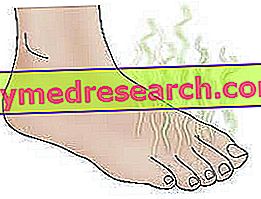Generality
Bromidrosis is a chronic condition in which the smell emanating from the skin becomes unpleasant. When it is particularly intense or significantly interferes with social life, bromidrosis takes on pathological aspects and requires specialized treatment.

Smell of the human body
Bromidrosis indicates an intensification of physiological body odors: it can develop in the armpit, soles of the feet or scalp and is not necessarily associated with hyperhidrosis.
Physiologically the body exudes a characteristic odor: this depends mainly on the type and quantity of bacterial flora present, which metabolizes substances secreted by the sweat glands or of keratinocyte derivation (scalp = sweat and sebum; axils = sweat; feet = sweat and keratin) . Even the intervention of certain factors, such as the presence of pathological conditions, the hormonal changes of a healthy person, certain foods and the intake of particular drugs can influence body odor.
Types of glands and their functions
The sweat glands are mainly divided into two types: eccrine and apocrine glands.
Eccrine sweat glands
The eccrine sweat glands are distributed over the entire skin surface and are particularly concentrated in the axillae, forehead, palms of the hands and soles of the feet. Their main function is to provide thermoregulation of the organism through the evaporation of sweat. Unlike the sebaceous glands, the production of secretion takes place without cell destruction or loss of the cytoplasm.
Eccrine sweat is a colorless liquid, clear and almost odorless, with a variable composition depending on the site: it contains 98-99% of water and 1% of inorganic solutes (eg NaCl) and organic substances (urea, uric acid, creatinine, lactic acid). Sweat secretion is discontinuous and regulated by various types of stimuli (physical, chemical, metabolic, nervous and emotional).
Apocrine sweat glands
The apocrine glands are present only in some areas: their distribution is limited to axillae, mammary areoles, inguinal and perineal region. Some apocrine elements are also found in the periorbital areas (eyelid margin) and periauricular areas (external acoustic meatus).
The apocrine glands are small and inactive during childhood, they do not play a role in thermoregulation, but they are responsible for characteristic pheromonal odors (whose function is to stimulate sexual interest in animals in particular). The glands produce, starting from puberty, a yellowish-white apocrine sweat, with a pungent odor and rich in various organic substances (glucides, proteins, lipids) and inorganic substances (such as iron). Excessive production of this sweat can generate an unpleasant odor and create problems in interpersonal relationships : the emission of the characteristic odor occurs following phenomena of bacterial decomposition of the secretion, which take place on the skin surface. Some studies show that individuals with bromidrosis have more numerous and larger apocrine glands. The control of the apocrine glands appears to be regulated by the sympathetic nervous system through peripheral mechanisms regulated by catecholamines.
| In summary: the function of the sweat glands | |
eccrine
| apocrine
|
Disorders related to abnormal functions of the sweat glands
| |
Although both types of bromidrosis can occur in subjects of every race, gender and age, there are some differences between the two forms:
Apocrine bromidrosis
Apocrine bromidrosis is the most common form and must be distinguished from the eccrine, less common form. The factors that contribute to the pathogenesis are different: the products of bacterial decomposition of apocrine sweat contain ammonia and short chain fatty acids; their presence produces strong and pungent characteristic odors.
The skin usually appears normal, except when bromidrosis is associated with concomitant dermatological diseases, such as erythrasma (an infection of bacterial origin, to be attributed to Corynebacterium minutissimum, which proliferates in wet areas, such as skin folds). Apocrine bromidrosis is more common in many Asian countries, often associated with a positive family history. Most cases mainly concern the male sex and occur after puberty (depending on the apocrine function), so it is rare in the elderly population.
Eccrine bromidrosis
In some cases, eccrine secretions, generally odorless, take on an invasive odor. The main cause of this form of bromidrosis is the bacterial degradation of keratin combined with eccrine sweat, which produces a bad smell. The ingestion of certain foods, including garlic, onion, curry, alcohol, some drugs (eg penicillin and bromides) and toxins can cause eccrine bromidrosis. Finally, this form of disorder can derive from metabolic causes (for example: trimethylaminuria or fish odor syndrome, which causes a defect in the degradation of trimethylamine, which is also released through sweating). Eccrine bromidrosis occurs in individuals of all races and can occur at any age.
Bromidrosis and hyperhidrosis. The role of hyperhidrosis (excessive secretion by the eccrine glands) in the pathogenesis of bromidrosis is not yet clear:
- It can promote the spread of apocrine sweat and contribute further to bromidrosis by creating a moist environment, ideal for bacterial proliferation.
- Or, on the contrary, eccrine hyperhidrosis can improve the symptoms of bromidrosis by "diluting" the smell of apocrine sweat.
Causes
The main cause that determines the production of bad odor associated with sweat secretions, can be traced back to an anomaly in quantity and quality of this phenomenon. The sweat that reaches the skin surface is initially odorless: the excessive secretion from the eccrine or apocrine glands is attacked by the native bacteria that live on our skin, which produce some "volatile" chemicals that can become, in some cases, smelly. In the hands, for example, it is the maceration of keratin induced by the amount of excess sweat that produces an unpleasant smell.
Factors such as poor hygiene, particular medical or dermatological conditions, hyperhidrosis or excessive growth of the skin bacterial flora, can contribute to the onset of the disorder.
Some conditions that favor the onset of bromidrosis are:
- Some general illnesses can be accompanied by a particular odor of the body and its secretions: trimethylaminuria, phenylketonuria, renal-hepatic insufficiency, brucellosis, etc.
- Coexistence of particular dermatoses that can contribute to the bad smell: intertrigo, mycosis etc.
- Pathological conditions that contribute to the onset of bromidrosis:
- Diabetes mellitus
- Obesity: overweight subjects tend to sweat more than a normal subject. This predisposition translates into the possibility of giving off an unpleasant smell with sweating.
- Type of food: consumption of spicy foods, garlic, onion, alcohol and caffeine should be limited. Drinking plenty of water helps to dilute the sweat and dampen the smell.
- Any medications that the patient occasionally or regularly takes.
- Familiarity: the majority of the patients in the family are affected by bromidrosis. A clinical study proposes an autosomal dominant pattern of transmission.
- Some medical texts trace the origin of bad smells to conditions such as gout, scurvy, or typhus, as a result of the extraction of metabolites contained in sweat.
Diagnosis
Bromidrosis is a metabolic and functional disease, generally not associated with any anatomical disorder. The skin appears normal, except in cases of association with concomitant dermatological disorders, such as erythrasma, which manifests itself as a strong macular eruption (similar to a mycosis) or axillary trichomicosis, a superficial bacterial infection that is localized on the hairs of the affected area (identifies the organic formations visible on the hairs). There are no instrumental machines that measure the smell of the human body, as specific tests of blood or sweat have not yet been standardized.
The first medical examination is entrusted to the subjective perception of the odor (for this it is important not to cover the natural odor of the body in order not to invalidate the test). Furthermore, in order to highlight an alteration of the bacterial flora it is possible to collect a sweat sample to be subjected to microbiological examination, and / or to inspect the skin surface with Wood's lamp, which allows to provide information on the presence of bacteria (such as the Corynebacterium minutissimum ) or of particular substances.
Note. Bromidrosis is a disorder that involves health both physically and psychically: it is essential to be able to distinguish the natural perception of the bad smell from the pathological condition that affects the skin.



